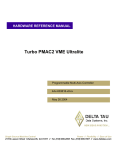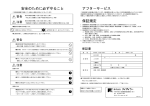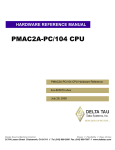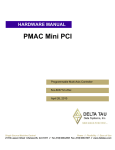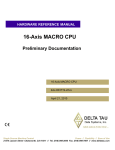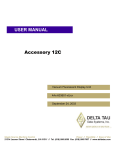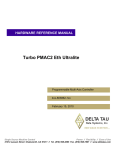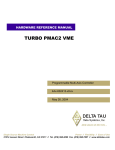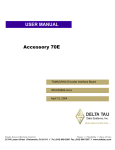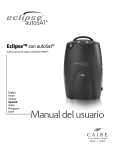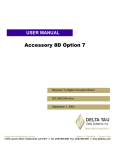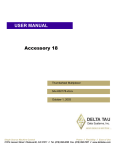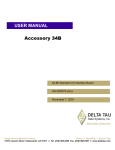Download acc-5e______________________________umac macro & i/o
Transcript
^1 USER MANUAL ^2 Accessory 5E ^3 UMAC MACRO & I/O ^4 3Ax-603437-xUxx ^5 October 23, 2003 Single Source Machine Control Power // Flexibility // Ease of Use 21314 Lassen Street Chatsworth, CA 91311 // Tel. (818) 998-2095 Fax. (818) 998-7807 // www.deltatau.com Copyright Information © 2003 Delta Tau Data Systems, Inc. All rights reserved. This document is furnished for the customers of Delta Tau Data Systems, Inc. Other uses are unauthorized without written permission of Delta Tau Data Systems, Inc. Information contained in this manual may be updated from time-to-time due to product improvements, etc., and may not conform in every respect to former issues. To report errors or inconsistencies, call or email: Delta Tau Data Systems, Inc. Technical Support Phone: (818) 717-5656 Fax: (818) 998-7807 Email: [email protected] Website: http://www.deltatau.com Operating Conditions All Delta Tau Data Systems, Inc. motion controller products, accessories, and amplifiers contain static sensitive components that can be damaged by incorrect handling. When installing or handling Delta Tau Data Systems, Inc. products, avoid contact with highly insulated materials. Only qualified personnel should be allowed to handle this equipment. In the case of industrial applications, we expect our products to be protected from hazardous or conductive materials and/or environments that could cause harm to the controller by damaging components or causing electrical shorts. When our products are used in an industrial environment, install them into an industrial electrical cabinet or industrial PC to protect them from excessive or corrosive moisture, abnormal ambient temperatures, and conductive materials. If Delta Tau Data Systems, Inc. products are directly exposed to hazardous or conductive materials and/or environments, we cannot guarantee their operation. Accessory 5E Table of Contents INTRODUCTION .....................................................................................................................................................1 ACC-5E Board Options ..........................................................................................................................................1 JUMPERS AND PINOUTS......................................................................................................................................3 Jumpers 1A - 1R Backplane Thumbwheel Port Connection...................................................................................3 RP4: SIP Resistor ....................................................................................................................................................4 RP5: SIP Resistor ....................................................................................................................................................4 S1: Dipswitch UBUS MACRO IC Base Address ...................................................................................................5 I/O CONFIGURATION ...........................................................................................................................................7 Multiplexer Port JTHW (J2) Setup .........................................................................................................................7 Hardware Characteristics ..................................................................................................................................7 Suggested M-Variables.......................................................................................................................................7 Direction Control ...............................................................................................................................................7 Inversion Control................................................................................................................................................8 Alternate Uses.....................................................................................................................................................8 JIO (J4) Setup..........................................................................................................................................................8 Hardware Characteristics ..................................................................................................................................8 Suggested M-Variables.......................................................................................................................................9 Direction Control ...............................................................................................................................................9 Inversion Control..............................................................................................................................................10 Alternate Uses...................................................................................................................................................10 Example Setup of JIO .......................................................................................................................................11 Display Port - JDISP (J6) Setup............................................................................................................................11 Handwheel Port – JHW (J7) Setup .......................................................................................................................11 Channel-Specific MACRO IC I-Variables........................................................................................................12 Encoder Input Setup .........................................................................................................................................12 PFM Output Setup ............................................................................................................................................13 UMAC MACRO & I/O BOARD CONNECTOR SUMMARY ..........................................................................15 UMAC MACRO & I/O CONNECTOR PINOUTS .............................................................................................17 J2: JTHW – Thumbwheel Port.............................................................................................................................17 J4: JI/O - General Purpose I/O Port .....................................................................................................................19 J6: JDISP - Display Port Connector.....................................................................................................................21 J7: JHW - Handwheel Port, Pulse and Direction Output Connector....................................................................22 TB1: Watchdog Relay Connector .........................................................................................................................23 J10,J11: MACRO I/O (Opt. B, C).........................................................................................................................23 P1: UBUS Interface Connector .............................................................................................................................25 U17: MACRO Fiber Optic Connector (OPT A, B)...............................................................................................26 UMAC MACRO & I/O MEMORY MAPS...........................................................................................................27 Identification and Configuration Register Map.....................................................................................................27 MACRO IC Base Address & Register Map..........................................................................................................28 Table of Contents i Accessory 5E ii Table of Contents Accessory 5E INTRODUCTION Delta Tau’s Universal Motion and Automation Controller (UMAC) combines the power of the PMAC controller with an integrated packaging and connectivity strategy that gives the user revolutionary flexibility and ease of use. The UMAC consists of a set of “3U” format Euro-cards (100 x 160 mm) that can be assembled in a variety of different strategies. The ACC-5E UMAC MACRO & I/O accessory (P/N 300-603437-10X) provides the interface capabilities for the LCD Display port, handwheel port, general purpose I/O port, thumbwheel port, and MACRO in both fiber and wire formats. ACC-5E Board Options ACC-5E: UMAC I/O and MACRO Accessory (Shown w/OPT2 & OPTB installed) This 3U-size rack-mounted board provides four general-purpose (non-servo) I/O ports for the UMAC: 1. 2. 3. 4. The JDISP display port The JTHW multiplexor port The JIO general-purpose I/O port The JHW handwheel port These are the same ports that are present along the top of a PC-bus PMAC2, or out the front of a VMEbus PMAC2. Optionally, it can also provide a 16-node or 32-node MACRO-ring interface. It connects to the CPU board through the UBUS backplane expansion port. It is intended for Pack use only. • • • • Option A: 16-node MACRO Interface with SC-style fiber-optic transceiver Option B: 16-node MACRO interface with SC-style fiber-optic transceiver and RJ-45 electrical connector Option C: 16-node MACRO interface with RJ-45 electrical connectors Option 2: Additional 16 nodes of MACRO interface (32 nodes total). Requires Option A, B, or C. Introduction 1 Accessory 5E 2 Introduction Accessory 5E JUMPERS AND PINOUTS The picture below shows the location of jumpers, resistor packs, dipswitch, and connectors: P5 -H J2 R W P4 TH IN W M -S R TE -J P IS D -J J6 ST JU AD W H AY -J PL IS J7 D ES D R LC IP N IO AT R JUMPERS 1A - 1R LINK INDICATOR J10 - RJ45 INPUT J5 - JISP J11 - RJ45 OUTPUT U17 - FIBER TRANSCEIVER S1 I/O -J J4 DO TB 1 H C H IT -W AT C SW IP G -D MACRO & I/O Card Layout (Shown w/OPTB installed) Note The ACC-5E accessory shown here is not the exact revision of the circuit board that is currently distributed. However, all the components represented here exist on current revisions. Jumpers 1A - 1R Backplane Thumbwheel Port Connection Install these 16 shorting bars when the backplane is used for thumbwheel port functions. The UBUS Specification does not require these lines to be connected and these backplane lines may actually be used for other purposes. Normally these jumpers are not installed. Jumpers and Pinouts 3 Accessory 5E RP4: SIP Resistor This common bussed 6-pin resistor pack is used to select between single-ended and differential handwheel encoder inputs. When placed with pin 1 of the resistor pack at pin 1 of the SIP socket, this resistor pack biases the negative side of the differential handwheel encoder inputs to 2.5Vdc. This is the configuration for singleended encoders. When placed with pin 1 of the resistor pack at pin 6 of the SIP socket, this resistor pack biases the negative side of the differential handwheel encoder inputs to 5Vdc. This is the configuration for differential encoders. Refer to the schematic below for the handwheel encoder input circuit: 10 1KSIP10C 2.2KSIP6C 2 3 4 5 6 7 8 9 6 5 4 3 2 2 3 4 5 6 7 8 9 SIP SOCKET TO CONNECTOR J7 1 RP3 2.2KSIP10C SIP SOCKET RP4 1 RP2 10 1 +5V 1 3 5 7 RP5 2 4 6 8 HW1_A1+ HW1_B1+ HW2_A2+ HW2_B2+ 220SIP8I GND HW2_B2HW2_A2HW1_B1HW1_A1- RP5: SIP Resistor This 8-pin resistor pack has 4 individual resistors that are used to apply a termination resistance between differential handwheel encoder inputs. Remove this resistor pack when using single-ended encoders to reduce a threshold shift that occurs when there is no negative side input. Refer to the schematic above for the application of RP5 in the handwheel encoder circuit. 4 Jumpers and Pinouts Accessory 5E S1: Dipswitch UBUS MACRO IC Base Address This 4-position dipswitch is used to select the UBUS address for the ACC-5E. ACC-5E Mapping Table {CS4 Mappings} MACRO & I/O SW1 Settings 4 on on on on on on on on off off off off off off off off 3 on on on on off off off off on on on on off off off off 2 on on off off on on off off on on off off on on off off 1 on off on off on off on off on off on off on off on off Turbo PMAC MACR O IC # (m) Base Channel Address 0 1 2 3 4 5 6 7 8 9 10 11 12 13 14 15 $78400 $79400 $7A400 $7B400 $78500 $79500 $7A500 $7B500 $78600 $79600 $7A600 $7B600 $78700 $79700 $7A700 $7B700 2nd Gate Array Base Address (OPT2) $79400 $7A400 $7B400 $78500 $79500 $7A500 $7B500 $78600 $79600 $7A600 $7B600 $78700 $79700 $7A700 $7B700 Not Availabl e Config. Ident. Address $78F10 $79F10 $7AF10 $7BF10 $78F14 $79F14 $7AF14 $7BF14 $78F18 $79F18 $7AF18 $7BF18 $78F1C $79F1C $7AF1C $7BF1C The memory mapping for the UBUS MACRO & I/O accessory allows 16 channels to be selected. The dipswitch selects between any of the 16 banks of memory. This allows for up to 16 ACC-5Es to be logically configured. Note The ACC-5E defines the mapping for its memory depending upon whether it is a single gate array or dual gate array device. The dual gate option for the ACC-5E is OPT-2. The 2nd gate array base addresses are shown in the last column of the table. Therefore, although there are 16 "slots" to place the ACC-5E into, these same "slots" may be occupied by MACRO accessory cards that have OPT2 installed. When this occurs, the accessory card occupies the equivalent of two slots and, therefore there may be fewer slots available for addressing. Be careful to allow for OPT2 addressing when more than one ACC-5E card is used! Note The ACC-5E with OPT-2 installed occupies 2 slots of address space. However, there is only one CS16-identification register for the accessory card even when OPT-2 is installed. Jumpers and Pinouts 5 Accessory 5E 6 Jumpers and Pinouts Accessory 5E I/O CONFIGURATION Two ports on the Accessory 5E may be used for general purpose I/O, the JIO (J4) port and the JTHW (J2) port. Although their setup is similar to setting them up for a PMAC2 PC, there are some addressing differences which need to be made clear. Multiplexer Port JTHW (J2) Setup The JTHW multiplexer port has 16 discrete digital I/O lines for general-purpose use. The lines are configurable by byte for input or output (on the DSPGATE2 I/O IC, the lines are individually configurable for input or output, but the buffer ICs are only byte-configurable), and individually configurable for inverting or non-inverting format. Hardware Characteristics When configured as an output, each line has a 5V CMOS totem-pole driver. This driver can sink or source up to 20 mA. There is a 10 κ pull-up resistor to 5V on each line for input purposes, but the driver IC can hold the line high or low despite this resistor. When configured as an input, the buffer IC presents a high-impedance input either sinking or sourcing; no significant current will flow. The pull-up resistor on the line will bias the line high in the absence of anything actively pulling the line low at significantly lower impedance. Suggested M-Variables The 16 I/O lines are memory-mapped into PMAC’s address space in register Y:$C082. Typically, these lines are used as a unit with specially designed multiplexing I/O accessories and appropriate multiplexing M-variables (TWB, TWD, TWR, and TWS formats), in which case PMAC2 handles the direct control of these I/O lines automatically. However, these lines can also be accessed individually with M-variables. Following is a suggested set of M-variable definitions to use these data lines: M40->Y:$078402,8 M41->Y:$078402,9 M42->Y:$078402,10 M43->Y:$078402,11 M44->Y:$078402,12 M45->Y:$078402,13 M46->Y:$078402,14 M47->Y:$078402,15 M48->Y:$078402,8,8,U M50->Y:$078402,0 M51->Y:$078402,1 M52->Y:$078402,2 M53->Y:$078402,3 M54->Y:$078402,4 M55->Y:$078402,5 M56->Y:$078402,6 M57->Y:$078402,7 M58->Y:$078402,0,8,U ; ; ; ; ; ; ; ; ; ; ; ; ; ; ; ; ; ; SEL0 Line; J2 Pin 4 SEL1 Line; J2 Pin 6 SEL2 Line; J2 Pin 8 SEL3 Line; J2 Pin 10 SEL4 Line; J2 Pin 12 SEL5 Line; J2 Pin 14 SEL6 Line; J2 Pin 16 SEL7 Line; J2 Pin 18 SEL0-7 Lines treated as a byte DAT0 Line; J2 Pin 3 DAT0 Line; J2 Pin 5 DAT0 Line; J2 Pin 7 DAT0 Line; J2 Pin 9 DAT0 Line; J2 Pin 11 DAT0 Line; J2 Pin 13 DAT0 Line; J2 Pin 15 DAT0 Line; J2 Pin 17 DAT0-7 Lines treated as a byte Direction Control In the default configuration set automatically at power-up/reset, DAT0 to DAT7 are set up as noninverting inputs; SEL0 to SEL7 are set up as non-inverting outputs with a zero (low voltage) value. If any of the multiplexer port accessories are to be used, this configuration must not be changed. The direction control bit for each of these I/O bits is located in the corresponding bit in the matching X register. For example, the direction control bit for DAT3 is located at X:$78402,3; the direction control bit for SEL6 is located at X:$78402,14. I/O Configuration 7 Accessory 5E Because the buffer ICs can only be switched by byte, it is best to define 8-bit M-variables for the direction control. Suggested definitions are: M60->X:$078402,0,8 M62->X:$078400,8,8 ; Direction control for DAT0 to DAT7 ; Direction control for SEL0 to SEL7 These M-variables should take values of 0 or 255 ($FF) only; 0 sets the byte to input, 255 sets the byte to output. In addition, the bi-directional buffer IC for each byte has a direction control line accessible as a software control bit. These control lines and bits must match the ASIC direction bits. In the UMAC version of the Turbo PMAC2, the buffer direction control bits are at UMAC address Y:$78F10,11 and Y:$78411,8. These address are based off the Configuration Identification Address chosen by the dip switch S1 setting. A bit value of 0 specifies input; 1 specifies output. Suggested M-variable definitions are: M61->Y:$78F10,11 M63->Y:$78F11,8 ; Buffer direction control for DAT0 to DAT7 ; Buffer direction control for SEL0 to SEL7 If it is desired to change either of these I/O bytes, it must be done by user programs (usually this is done in PLC 1 acting as a reset PLC, scanning through once on power-up/reset, then disabling itself). Inversion Control Each line on the JTHW port is individually controllable as to whether it is an inverting I/O point (0=+5V; 1=0V) or a non-inverting I/O point (0=0V; 1=+5V). Register X:$78406 contains the inversion control bits: X:$78406 bits 0 to 7 control DAT0 to DAT7, respectively X:$78406 bits 8 to 15 control SEL0 to SEL7, respectively A value of 0 in the control bit sets the corresponding I/O point as non-inverting. A value of 1 in the control bits sets the corresponding I/O point as inverting. At power-up/reset, PMAC automatically sets all of the I/O points on the JTHW port as non-inverting. To use any of the multiplexed I/O accessory boards on the JTHW port, all I/O points on the port must be left non-inverting. Alternate Uses Because of the byte-wide direction-control buffer ICs, it is not possible to use all of the I/O points on the JTHW in their alternate uses. Each general-purpose I/O point on the JTHW port has an alternate use as a supplemental fixed-use I/O point on a supplemental machine interface channel (1* or 2*). The points are individually controllable as to general-purpose use or fixed use by control register Y:$78406. Refer to this register in the memory-I/O map to see the alternate uses of each point. At power-up/reset, UMAC automatically sets up all of the I/O points on the port for general-purpose use. JIO (J4) Setup The JIO port has 32 discrete digital I/O lines for general-purpose use. The lines are configurable by byte for input or output (on the DSPGATE2 I/O IC, the lines are individually configurable for input or output, but the buffer ICs are only byte-configurable), and individually configurable for inverting or noninverting format. Hardware Characteristics Because all of these lines default to inputs at power-up/ reset, any lines used as outputs will pull to +5V at power-up/reset until software configures them as outputs. 8 I/O Configuration Accessory 5E When configured as an output, each line has a 5V CMOS totem-pole driver. This driver can sink or source up to 20 mA. There is a 10 κ pull-up resistor to 5V on each line for input purposes, but the driver IC can hold the line high or low despite this resistor. When configured as an input, the buffer IC presents a high-impedance sinking input; no significant current will flow. The pull-up resistor on the line will bias the line high in the absence of anything actively pulling the line low at significantly lower impedance. Suggested M-Variables The 32 I/O lines are memory-mapped into UMAC’s address space in the registers Base Address and Base Address+1, depending on SW2 settings. Typically these I/O lines are accessed individually with Mvariables. Following is a suggested set of M-variable definitions to use these data lines with a base address of $78400: M0->Y:$78400,0 ; I/O00 Data Line; J3 Pin 1 M1->Y:$78400,1 ; I/O01 Data Line; J3 Pin 2 M2->Y:$78400,2 ; I/O02 Data Line; J3 Pin 3 M3->Y:$78400,3 ; I/O03 Data Line; J3 Pin 4 M4->Y:$78400,4 ; I/O04 Data Line; J3 Pin 5 M5->Y:$78400,5 ; I/O05 Data Line; J3 Pin 6 M6->Y:$78400,6 ; I/O06 Data Line; J3 Pin 7 M7->Y:$78400,7 ; I/O07 Data Line; J3 Pin 8 M8->Y:$78400,8 ; I/O08 Data Line; J3 Pin 9 M9->Y:$78400,9 ; I/O09 Data Line; J3 Pin 10 M10->Y:$78400,10 ; I/O10 Data Line; J3 Pin 11 M11->Y:$78400,11 ; I/O11 Data Line; J3 Pin 12 M12->Y:$78400,12 ; I/O12 Data Line; J3 Pin 13 M13->Y:$78400,13 ; I/O13 Data Line; J3 Pin 14 M14->Y:$78400,14 ; I/O14 Data Line; J3 Pin 15 M15->Y:$78400,15 ; I/O15 Data Line; J3 Pin 16 M16->Y:$78400,16 ; I/O16 Data Line; J3 Pin 17 M17->Y:$78400,17 ; I/O17 Data Line; J3 Pin 18 M18->Y:$78400,18 ; I/O18 Data Line; J3 Pin 19 M19->Y:$78400,19 ; I/O19 Data Line; J3 Pin 20 M20->Y:$78400,20 ; I/O20 Data Line; J3 Pin 21 M21->Y:$78400,21 ; I/O21 Data Line; J3 Pin 22 M22->Y:$78400,22 ; I/O22 Data Line; J3 Pin 23 M23->Y:$78400,23 ; I/O23 Data Line; J3 Pin 24 M24->Y:$78401,0 ; I/O24 Data Line; J3 Pin 25 M25->Y:$78401,1 ; I/O25 Data Line; J3 Pin 26 M26->Y:$78401,2 ; I/O26 Data Line; J3 Pin 27 M27->Y:$78401,3 ; I/O27 Data Line; J3 Pin 28 M28->Y:$78401,4 ; I/O28 Data Line; J3 Pin 29 M29->Y:$78401,5 ; I/O29 Data Line; J3 Pin 30 M30->Y:$78401,6 ; I/O30 Data Line; J3 Pin 31 M31->Y:$78401,7 ; I/O31 Data Line; J3 Pin 32 Direction Control The direction control bit for each of these I/O bits is located in the corresponding bit in the matching X register. For example, with the base address set at $78400 the direction control bit for I/O03 is located at X:$78400,3; the direction control bit for I/O30 is located at X:$78401,6. Because the buffer ICs can only be switched by byte, it is best to define 8-bit M-variables for the direction control. Suggested definitions are: M32->X:$78400,0,8 ; Direction control for I/O00 to I/O07 M34->X:$78400,8,8 ; Direction control for I/O08 to I/O15 M36->X:$78400,16,8 ; Direction control for I/O16 to I/O23 M38->X:$78401,0,8 ; Direction control for I/O24 to I/O31 I/O Configuration 9 Accessory 5E These M-variables should take values of 0 or 255 ($FF) only; 0 sets the byte to input, 255 sets the byte to output. The default values are zero for all of the above registers. In addition, the bidirectional buffer IC for each byte has a direction control line accessible as a software control bit. These control lines and bits must match the ASIC direction bits. The buffer direction control bits are at the UMAC Configuration Identification Address (depends on SW2), with bits 7 to 10 controlling the four bytes of the JIO port. A bit value of 0 specifies input; 1 specifies output. With base address of $78400, the suggested M-variable definitions are: M33->Y:$78F10,7 ; Buffer direction control for I/O00 to I/O07 M35->Y:$78F10,8 ; Buffer direction control for I/O08 to I/O15 M37->Y:$78F10,9 ; Buffer direction control for I/O16 to I/O23 M39->Y:$78F10,10 ; Buffer direction control for I/O24 to I/O31 In the default configuration automatically set at power-up/reset, I/O00 to I/O31 are set up as inputs (M32 through M39 = 0). This is done for maximum safety; no lines can be forced into an undesirable high or low state. Any of these lines that are to be used as outputs must be changed to outputs by user programs (usually this is done in PLC 1 acting as a reset PLC, scanning through once on power-up/reset, then disabling itself). Inversion Control Each line on the JIO port is individually controllable as to whether it is an inverting I/O point (0=+5V; 1=0V) or a non-inverting I/O point (0=0V; 1=+5V). For base address $78400, registers X:$78404 and X:$78405 contain the inversion control bits: X:$78404 bits 0 to 23 control I/O00 to I/O23, respectively X:$78405 bits 0 to 7 control I/O24 to I/O31, respectively Suggested M-Variable definitions m41->x:$78404,0,8 m42->x:$78404,8,8 m43->x:$78404,16,8 m44->x:$78405,0,8 m45->x:$78404,0,24 A value of 0 in the control bit sets the corresponding I/O point as inverting. A value of 1 in the control bits sets the corresponding I/O point as non-inverting. At power-up/reset, UMAC automatically sets all of the I/O points on the JIO port as inverting. On power up all of the inputs are at zero and pulled up to 5V. Alternate Uses The direction-control of the buffer ICs must be set properly for the alternate uses of the I/O points, just as for the general-purpose I/O uses. These lines must be set properly at power up. Each general-purpose I/O point on the JIO port has an alternate use as a supplemental fixed-use I/O point on a supplemental machine interface channel (1* or 2*). The default setting of configures this port for the general purpose I/O. If the user needs the supplemental channel registers, then you must set these bits to 0 at power up to use each line as a general-purpose I/O point. The points are individually controllable as to general-purpose use or fixed use by control registers Y:$78404 and Y:$78405, when base address is at $78400. Refer to these registers in the memory-I/O map to see the alternate uses of each point. At powerup/ reset, UMAC automatically sets up all of the I/O points on the port for general-purpose use Suggested M-Variable Definitions M46->Y:$78404,0,24 M47->Y:$78405,0,8 10 ;setup for IO0-23 ;setup for IO24-32 I/O Configuration Accessory 5E Example Setup of JIO If the above definitions were made, we could set these variables to their proper values in an initialization PLC. This example sets up the first 2 bytes as outputs and the second 2 bytes as inputs. All set to noninverting. I usually will use the following technique for an initialization PLC, #define #define #define #define #define #define #define #define #define #define #define #define DIR_CONTROL_1 BUFF_CONTROL_1 DIR_CONTROL_2 BUFF_CONTROL_2 DIR_CONTROL_3 BUFF_CONTROL_3 DIR_CONTROL_4 BUFF_CONTROL_4 INV_CTRL_0_23 INV_CTRL_24_31 Alt_use_0_23 Alt_use_24_31 m32 m33 m34 m35 m36 m37 m38 m39 m45 m44 m46 m47 OPEN PLC 6 CLEAR DIR_CONTROL_1 = 255 ;set as output BUF_CONTROL_1 = 1 ;set as output DIR_CONTROL_2 = 255 ;set as output BUF_CONTROL_2 = 1 ;set as output DIR_CONTROL_3 = 0 ;set as input BUF_CONTROL_3 = 0 ;set as input DIR_CONTROL_4 = 0 ;set as input BUF_CONTROL_4 = 0 ;set as input INV_CTRL_0_23 = $FFFF ;set as non-inverting INV_CTRL_24_31 =$FF ;set as non-inverting Alt_use_0_23 = $FFFFFF Alt_use_0_7 = $FF ;place other initialization variables here while (1<2) ;PLC in here (perhaps E_STOP routine) . . endwhile CLOSE Display Port - JDISP (J6) Setup The JDISP connector (J6) allows connection of the ACC-12 or ACC-12A liquid crystal displays, or of the Acc-12C vacuum fluorescent display. Both text and variable values may be shown on these displays using the DISPLAY command, executing in either motion or PLC programs. Handwheel Port – JHW (J7) Setup The Handwheel port on the Acc5E is a convenient and cheap tool to use for an extra two encoder inputs and two PFM outputs. The encoder input lines do not provide a method for inputting an index pulse, but quadrature encoder input is available. The 2 PFM outputs can used be used in many different applications including driving stepper motors or laser outputs. I/O Configuration 11 Accessory 5E Channel-Specific MACRO IC I-Variables (For MACRO IC Channel n*, where n* = 1 to 2) I-Variables in the I6810s, I6820s, I6910s, and I6920s control the hardware aspects of the MACRO IC “DSPGATE2” ASIC that provides the machine interface for supplemental channels 1 and 2. Note that few of these functions are normally used on the Turbo PMAC2s. By default, only the two encoder inputs and the two C-channel PWM/PFM outputs are used. These I-variables are not active if the MACRO IC is not present, or is a “MACROGATE” IC. Encoder Input Setup To set up a supplemental encoder channel through the thumbwheel port, there is very little software setup involved. One parameter you will have to change is the encoder decode. This UMAC I variable is I68n0 or I69n0, where is the supplemental channel. There is firmware support for a system with 4 Acc5E’s addressed to Macro IC #0-3 (based on the settings of S1). You could then access to 8 supplemental encoder channels with I-variable pointers. Since it is possible to connect up to 16 Accessory 5Es into a system, there are methods available to set up additional supplemental encoders through M-Variable pointers. Consult Delta Tau Technical Support if you wish to bring in more than 8 supplemental encoder channels. I68n0/I69n0 I68n0 and I69n0 control how the encoder input signal for Channel n* (n* = 1 to 2) on a “DSPGATE2” MACRO IC is decoded into counts. For MACRO ICs 0 and 2, n = n*; for MACRO ICs 1 and 3, n = n* + 5 (i.e. I6810 controls MACRO IC 0 Channel 1; I6970 controls MACRO IC 3 Channel 2). As such, this defines the sign and magnitude of a “count”. The following settings may be used to decode an input signal. I68n0/I69n0 = 0: Pulse and direction CW I68n0/I69n0 = 1: x1 quadrature decode CW I68n0/I69n0 = 2: x2 quadrature decode CW I68n0/I69n0 = 3: x4 quadrature decode CW I68n0/I69n0 = 4: Pulse and direction CCW I68n0/I69n0 = 5: x1 quadrature decode CCW I68n0/I69n0 = 6: x2 quadrature decode CCW I68n0/I69n0 = 7: x4 quadrature decode CCW I68n0/I69n0 = 8: Internal pulse and direction I68n0/I69n0 = 9: Not used I68n0/I69n0 = 10: Not used I68n0/I69n0 = 11: x6 hall format decode CW* I68n0/I69n0 = 12: MLDT pulse timer control (Internal pulse resets timer; external pulse latches timer) I68n0/I69n0 = 13: Not used I68n0/I69n0 = 14: Not used I68n0/I69n0 = 15: x6 hall format decode CCW* *Requires version B or newer of the DSPGATE2 MACRO IC. 12 I/O Configuration Accessory 5E After setting up the decode properties you can process the data in the encoder conversion table. The encoder counter data for the first encoder will be located at the BaseAddress+11 from your SW1 setting. The second channel of encoder data will be at BaseAddress+19. The following is an example for the encoder conversion table settings for an Accessory 5E with two encoders wired into the Handwheel port and switch settings for a base address of $78400. I6810=7 I6820=7 I8008=$78410 I8009=$78418 I903=$3509 I904=$3509 I1003=$350a I1004=$350a ;x4 quadrature decode CCW ;x4 quadrature decode CCW ;1/T interpolation where data is at $78411 at 9th ;entry of ECT ;1/T interpolation where data is at $78419 at ;10th entry of ECT ;Motor 9 position is now set up for position ;feedback through the handwheel port ;Motor 9 position is now set up for velocity feedback through the handwheel port ;Motor 10 position is now set up for position feedback through the handwheel port ;Motor 10 position is now set up for velocity feedback through the handwheel port Alternatively, you could use the data from the following M-Variables: M901->X:$78411,0,24 M991->X:$3509,0,24 M1001->X:$78419,0,24 M1091->X:$350a,0,24 ;encoder counter for handwheel encoder 1 ;output from the encoder conversion table with ;1/T interpolation ;encoder counter for handwheel encoder 1 ;output from the encoder conversion table with ;1/T interpolation I68n2/I69n2 and I68n3/I69n3 are used to setup the encoder capture characteristics (see Turbo Software Reference Manual). If you are using the encoder capture function, the captured data will be located at X:$BaseAddress+3,0,24. PFM Output Setup There is also very little setup needed when configuring the 2 PFM output signals on the Handwheel port of the 5E. Variables I68n6/I69n6 through I68n8/I69n8 are the variables provided through firmware. You can reference all of these variables in the Turbo Software Reference Manual. I68n6/I69n6 I68n6/I69n6 = 0: Outputs A & B are PWM; Output C is PWM I68n6/I69n6 = 1: Outputs A & B are DAC; Output C is PWM I68n6/I69n6 = 2: Outputs A & B are PWM; Output C is PFM I68n6/I69n6 = 3: Outputs A & B are DAC; Output C is PFM Since we want PFM outputs we would select a value of 2 or 3 for this variable. The output register will then be located at address $BaseAddress+4,8,16,s for the first PFM output and $BaseAddress+12,8,16,s for the second PFM channel. Example for Base Address of $78400: I6816=3 I6826=3 M902->X:$78414,8,16,S M1002->X:$7841C,8,16,S I/O Configuration ;first supplemental channel output mode ;second supplemental channel output mode ;first supplemental output channel PFM address ;Second supplemental output channel PFM address 13 Accessory 5E Now by setting M902 or M1002 to a value, you will see the PFM output on pins 11-18 on the handwheel port. The maximum value of M902 or M1002 is 32767 will corresponds to a PFM value ½ the PFM clock set by I6803. The pulse width is configured through I6804 for all of the channels at the same base address. Reference the Turbo Software Reference Manual for all of the details of this setup. 14 I/O Configuration Accessory 5E UMAC MACRO & I/O BOARD CONNECTOR SUMMARY J2: JTHW - Thumbwheel port connector: 26-pin box header connector J3: JIO - I/O interface connector (32 I/O lines): 40-pin box header connector J5: JTAG - Programming header (Factory use only) J6: JDISP - Alphanumeric display connector: 14-pin box header J7: JHW - Handwheel port, pulse and direction output combined: 20-pin box header J9: WD - Watchdog relay connector: 4-pin mini-combicon connector J10: RJ45IN - MACRO wire-based input: 8-pin RJ45 connector (OPTB or OPTC only) J11: RJ45OUT - MACRO wire-based output: 8-pin RJ45 connector (OPTB or OPTC only) P1: JEXP - UBUS Interface (96-pin DIN connector) U17: OPTOXCVR - MACRO Fiber optic interface: 2- SC style optical connectors (OPTA or OPTB only) UMAC MACRO & I/O Board Connector Summary 15 Accessory 5E 16 UMAC MACRO & I/O Board Connector Summary Accessory 5E UMAC MACRO & I/O CONNECTOR PINOUTS The schematic circuits shown in this section are for interface reference only. Subtle differences may exist between the circuits shown here and the actual hardware used. J2: JTHW – Thumbwheel Port (26-pin Header) Pin # Symbol Function Description Front View Notes 1 GND Common Power Supply Return 2 GND Common Power Supply Return 3 DAT0 Bidirect Thumbwheel Data Line 0 4 SEL0 Bidirect Thumbwheel Select Line 0 5 DAT1 Bidirect Thumbwheel Data Line 1 6 SEL1 Bidirect Thumbwheel Select Line 1 7 DAT2 Bidirect Thumbwheel Data Line 2 8 SEL2 Bidirect Thumbwheel Select Line 2 9 DAT3 Bidirect Thumbwheel Data Line 3 10 SEL3 Bidirect Thumbwheel Select Line 3 11 DAT4 Bidirect Thumbwheel Data Line 4 12 SEL4 Bidirect Thumbwheel Select Line 4 13 DAT5 Bidirect Thumbwheel Data Line 5 14 SEL5 Bidirect Thumbwheel Select Line 5 15 DAT6 Bidirect Thumbwheel Data Line 6 16 SEL6 Bidirect Thumbwheel Select Line 6 17 DAT7 Bidirect Thumbwheel Data Line 7 18 SEL7 Bidirect Thumbwheel Select Line 7 19 n.c. Not Connected 20 GND Common Power Supply Return 21 n.c. Not Connected 22 GND Common Power Supply Return 23 n.c. Not Connected 24 GND Common Power Supply Return 25 +5V Vcc Power Supply Pwr supply output from UBUS backplane 26 n.c. Not Connected The JTHW connector provides the UMAC system with the ability to communicate either by using the thumbwheel port protocol or by a user-created parallel means. UMAC MACRO & I/O Connector Pinouts 17 Accessory 5E +5V +5V U9 48 47 46 45 44 43 42 41 40 39 38 37 36 35 34 33 32 31 30 29 28 27 26 25 DATA_0 DATA_1 DATA_2 DATA_3 DATA_4 DATA_5 DATA_6 DATA_7 C23 OE1 A0 A1 GND A2 A3 VCC A4 A5 GND A6 A7 A8 A9 GND A10 A11 VCC A12 A13 GND A14 A15 OE2 T/R1 B0 B1 GND B2 B3 VCC B4 B5 GND B6 B7 B8 B9 GND B10 B11 VCC B12 B13 GND B14 B15 T/R2 74FCT16245ATA (TSSOP) .1UF 1 2 3 4 5 6 7 8 9 10 11 12 13 14 15 16 17 18 19 20 21 22 23 24 J2 J2 OUT4 C24 .1UF GND GND +5V +5V U10 SEL_6 SEL_7 C25 .1UF GND 74FCT16245ATA (TSSOP) 9 8 7 6 5 4 3 2 RP10 RP11 1 +5V 10KSIP10C 10 SEL_4 SEL_5 OUT5 1 2 3 4 5 6 7 8 9 10 11 12 13 14 15 16 17 18 19 20 21 22 23 24 1 SEL_2 SEL_3 T/R1 B0 B1 GND B2 B3 VCC B4 B5 GND B6 B7 B8 B9 GND B10 B11 VCC B12 B13 GND B14 B15 T/R2 9 8 7 6 5 4 3 2 SEL_0 SEL_1 OE1 A0 A1 GND A2 A3 VCC A4 A5 GND A6 A7 A8 A9 GND A10 A11 VCC A12 A13 GND A14 A15 OE2 10 48 47 46 45 44 43 42 41 40 39 38 37 36 35 34 33 32 31 30 29 28 27 26 25 1 2 3 4 5 6 7 8 9 10 11 12 13 14 15 16 17 18 19 20 21 22 23 24 25 26 DAT0 SEL0 DAT1 SEL1 DAT2 SEL2 DAT3 SEL3 DAT4 SEL4 DAT5 SEL5 DAT6 SEL6 DAT7 SEL7 10KSIP10C (JTHW) GND GND DAT0 SEL0 DAT1 SEL1 DAT2 SEL2 DAT3 SEL3 DAT4 SEL4 DAT5 SEL5 DAT6 SEL6 DAT7 SEL7 N.C. GND N.C. GND N.C. GND +5V N.C. HEADER 26 GND C26 .1UF GND Circuitry for J2 JTHW Interface 18 UMAC MACRO & I/O Connector Pinouts Accessory 5E J4: JI/O - General Purpose I/O Port (40-pin Header) Front View Pin # Symbol Function 1 2 3 4 5 6 7 8 9 10 11 12 13 14 15 16 17 18 19 20 21 22 23 24 25 26 27 28 29 30 31 32 33 34 35 36 37 38 39 40 I/O00 I/O01 I/O02 I/O03 I/O04 I/O05 I/O06 I/O07 I/O08 I/O09 I/O10 I/O11 I/O12 I/O13 I/O14 I/O15 I/O16 I/O17 I/O18 I/O19 I/O20 I/O21 I/O22 I/O23 I/O24 I/O25 I/O26 I/O27 I/O28 I/O29 I/O30 I/O31 GND GND PHASE SERVO GND GND +5V Bidirect Bidirect Bidirect Bidirect Bidirect Bidirect Bidirect Bidirect Bidirect Bidirect Bidirect Bidirect Bidirect Bidirect Bidirect Bidirect Bidirect Bidirect Bidirect Bidirect Bidirect Bidirect Bidirect Bidirect Bidirect Bidirect Bidirect Bidirect Bidirect Bidirect Bidirect Bidirect Common Common Output Output Common Common Vcc Vcc +5V UMAC MACRO & I/O Connector Pinouts Description Input or Output #00 Input or Output #01 Input or Output #02 Input or Output #03 Input or Output #04 Input or Output #05 Input or Output #06 Input or Output #07 Input or Output #08 Input or Output #09 Input or Output #10 Input or Output #11 Input or Output #12 Input or Output #13 Input or Output #14 Input or Output #15 Input or Output #16 Input or Output #17 Input or Output #18 Input or Output #19 Input or Output #20 Input or Output #21 Input or Output #22 Input or Output #23 Input or Output #24 Input or Output #25 Input or Output #26 Input or Output #27 Input or Output #28 Input or Output #29 Input or Output #30 Input or Output #31 Power Supply Return Power Supply Return Phase Clock Output Servo Clock Output Power Supply Return Power Supply Return Power Supply Power Supply Notes Pwr supply output from UBUS backplane Pwr supply output from UBUS backplane 19 Accessory 5E +5V +5V U10 48 47 46 45 44 43 42 41 40 39 38 37 36 35 34 33 32 31 30 29 28 27 26 25 IO_00 IO_01 IO_02 IO_03 IO_04 IO_05 IO_06 IO_07 C25 OE1 A0 A1 GND A2 A3 VCC A4 A5 GND A6 A7 A8 A9 GND A10 A11 VCC A12 A13 GND A14 A15 OE2 T/R1 B0 B1 GND B2 B3 VCC B4 B5 GND B6 B7 B8 B9 GND B10 B11 VCC B12 B13 GND B14 B15 T/R2 1 2 3 4 5 6 7 8 9 10 11 12 13 14 15 16 17 18 19 20 21 22 23 24 OUT5 OUT0 J3 74FCT16245ATA (TSSOP) C26 J3 .1UF .1UF I/O00 I/O01 I/O02 I/O03 I/O04 I/O05 I/O06 I/O07 I/O08 I/O09 I/O10 I/O11 I/O12 I/O13 I/O14 I/O15 I/O16 I/O17 I/O18 I/O19 I/O20 I/O21 I/O22 I/O23 I/O24 I/O25 I/O26 I/O27 I/O28 I/O29 I/O30 I/O31 U11 OUT2 74FCT16245ATA (TSSOP) C28 .1UF IO_28 IO_29 IO_30 IO_31 PHASE SERVO C29 .1UF GND T/R1 B0 B1 GND B2 B3 VCC B4 B5 GND B6 B7 B8 B9 GND B10 B11 VCC B12 B13 GND B14 B15 T/R2 74FCT16245ATA (TSSOP) 1 2 3 4 5 6 7 8 9 10 11 12 13 14 15 16 17 18 19 20 21 22 23 24 OUT3 RP12 10 IO_26 IO_27 OE1 A0 A1 GND A2 A3 VCC A4 A5 GND A6 A7 A8 A9 GND A10 A11 VCC A12 A13 GND A14 A15 OE2 10KSIP10C RP13 10KSIP10C RP14 10KSIP10C RP15 1 U12 48 47 46 45 44 43 42 41 40 39 38 37 36 35 34 33 32 31 30 29 28 27 26 25 1 2 3 4 5 6 7 8 9 10 11 12 13 14 15 16 17 18 19 20 21 22 23 24 25 26 27 28 29 30 31 32 33 34 35 36 37 38 39 40 9 8 7 6 5 4 3 2 .1UF IO_24 IO_25 10 C27 1 IO_22 IO_23 9 8 7 6 5 4 3 2 IO_20 IO_21 10 IO_18 IO_19 1 IO_14 IO_15 IO_16 IO_17 9 8 7 6 5 4 3 2 IO_12 IO_13 T/R1 B0 B1 GND B2 B3 VCC B4 B5 GND B6 B7 B8 B9 GND B10 B11 VCC B12 B13 GND B14 B15 T/R2 10 IO_10 IO_11 OE1 A0 A1 GND A2 A3 VCC A4 A5 GND A6 A7 A8 A9 GND A10 A11 VCC A12 A13 GND A14 A15 OE2 OUT1 1 IO_08 IO_09 1 2 3 4 5 6 7 8 9 10 11 12 13 14 15 16 17 18 19 20 21 22 23 24 9 8 7 6 5 4 3 2 48 47 46 45 44 43 42 41 40 39 38 37 36 35 34 33 32 31 30 29 28 27 26 25 +5V 10KSIP10C (JI/O) I/O00 I/O01 I/O02 I/O03 I/O04 I/O05 I/O06 I/O07 I/O08 I/O09 I/O10 I/O11 I/O12 I/O13 I/O14 I/O15 I/O16 I/O17 I/O18 I/O19 I/O20 I/O21 I/O22 I/O23 I/O24 I/O25 I/O26 I/O27 I/O28 I/O29 I/O30 I/O31 GND GND PHASESERVOGND GND +5V +5V HEADER 40 GND C30 .1UF GND Circuitry For J3 JI/O Interface 20 UMAC MACRO & I/O Connector Pinouts Accessory 5E J6: JDISP - Display Port Connector (14-pin Header) Pin # 1 2 3 4 5 6 7 8 9 10 11 12 13 14 Note 1: Note 2: Note 3: Note 4: Symbol Function Description Front View Notes +5V Vcc Power Supply Pwr supply output from UBUS backplane GND Common Power Supply Return RS Output Read Select Connected to OUT8Vee Output LCD Display Intensity Pot adjusts between 5V and GND E Output LCD Display Enable Connected to OUT7R/WOutput Read/write- Signal Connected to OUT6DB1 Bidirect Data Bit 1 DB0 Bidirect Data Bit 0 DB3 Bidirect Data Bit 3 DB2 Bidirect Data Bit 2 DB5 Bidirect Data Bit 5 DB4 Bidirect Data Bit 4 DB7 Bidirect Data Bit 7 DB6 Bidirect Data Bit 6 Upon a clear-reset power-up, this port will automatically output data to the LCD device. This port is designed to operate with the ACC-12 display products from Delta Tau Data Systems Inc. This port is capable of being used as an 8-bit parallel input or output. The value of Y:$10D0 (for Turbo UMAC) is set to $80 for ACC-12A (LCD Display). Set this register to $16 for ACC-12C (Vacuum Fluorescent Display) or basic parallel output from the display buffer register. Set this register to 00 if the JDISP connector is to be used as an 8-bit parallel port. UMAC MACRO & I/O Connector Pinouts 21 Accessory 5E J7: JHW - Handwheel Port, Pulse and Direction Output Connector (20-pin Header) Front View Pin # Symbol Function 1 2 3 4 5 6 7 8 9 10 11 12 13 14 15 16 17 18 19 20 GND +5V HW1_A+ HW1_AHW1_B+ HW1_BHW2_A+ HW2_AHW2_B+ HW2_BPUL1+ PUL1DIR1+ DIR1PUL2+ PUL2DIR2+ DIR2GND +5V Common Vcc Input Input Input Input Input Input Input Input Output Output Output Output Output Output Output Output Common Vcc Description Notes Power Supply Return Power Supply Handwheel #1 'A+' Input Handwheel #1 'A-' Input Handwheel #1 'B+' Input Handwheel #1 'B-' Input Handwheel #2 'A+' Input Handwheel #2 'A-' Input Handwheel #2 'B+' Input Handwheel #2 'B-' Input Pulse Output #1+ Pulse Output #1Direction Output #1+ Direction Output #1Pulse Output #2+ Pulse Output #2Direction Output #2+ Direction Output #2Power Supply Return Power Supply Pwr supply output from UBUS backplane Pwr supply output from UBUS backplane 10 RP2 1 10 1 +5V RP3 SIP SOCKET 1 6 5 4 3 2 1KSIP10C SIP SOCKET 2 3 4 5 6 7 8 9 RP4 HW1_A1HW1_B1HW2_A2HW2_B2- 2.2KSIP6C 1 3 5 7 RP5 2 3 4 5 6 7 8 9 2.2KSIP10C 2 4 6 8 HW1_A1+ HW1_B1+ HW2_A2+ HW2_B2+ 220SIP8I GND +5V U8 VCC HW1_A1 3 4 OUT-A IN-A IN-A EN-A,C IN-C HW1_B1 5 HW2_A2 13 12 OUT-C IN-C OUT-B IN-B IN-B EN-B,D IN-D HW2_B2 11 OUT-D J7 +5V U7 IN-D GND 16 J7 VCC 2 HW1_A1+ 1 HW1_A1- 7 HW1_B1- 6 HW1_B1+ PUL_1 7 14 HW2_A2+ DIR_2 15 15 HW2_A2- DIR_1 1 4 HW2_B2- 10 HW2_B2+ OUT-A OUT-A EN-A,C OUT-C 12 9 IN-A IN-C IN-B OUT-C OUT-B OUT-B EN-B,D OUT-D PUL_2 9 IN-D 8 OUT-D GND ST34C86CF16 (SO16) 16 2 DIR_1+ 3 DIR_1- 5 PUL_1- 6 PUL_1+ 14 DIR_2+ 13 DIR_2- 11 PUL_2- 10 PUL_2+ 8 GND +5V ST34C87CF16 (SO16) HW1_A1+ HW1_A1HW1_B1+ HW1_B1HW2_A2+ HW2_A2HW2_B2+ HW2_B2PUL_1+ PUL_1DIR_1+ DIR_1PUL_2+ PUL_2DIR_2+ DIR_2- 1 2 3 4 5 6 7 8 9 10 11 12 13 14 15 16 17 18 19 20 (JHW,PD) GND +5V HW1_A1+ HW1_A1HW1_B1+ HW1_B1HW2_A2+ HW2_A2HW2_B2+ HW2_B2PUL_1+ PUL_1DIR_1+ DIR_1PUL_2+ PUL_2DIR_2+ DIR_2GND +5V HEADER 20 C21 .1UF GND GND +5V C22 .1UF GND Circuitry For J7 JHW Interface 22 UMAC MACRO & I/O Connector Pinouts Accessory 5E TB1: Watchdog Relay Connector (4 pin Mini-Combicon) Pin # Symbol Function 1 NC Relay Contact Normally closed contact Description 2 3 COM NO Relay Contact Relay Contact Watchdog Common Normally open contact 4 COM Relay Contact Watchdog Common Front View Notes This Pin is connected to J9-2 and J9-4 when the watchdog is tripped. Connected to pin 4. This pin is connected to J9-2 and J9-4 when the system is functioning normally. This pin is disconnected when the Watchdog circuit trips (error condition). Connected to pin 2. J9-WD +5V K1 J9 3 4 3 5 D2 10 1 2 3 4 NC COM NO COM 9 8 MMBD301LT1 (SOT23) 1 1 1 12 FBR12ND05 Q1 2N7002 3 2 SOT23 GND Watchdog Relay Circuit J10,J11: MACRO I/O (Opt. B, C) (8 pin RJ45) Pin # Symbol Function Description 1 DATA+ Data + Differential MACRO Signal. Front View Notes J10: DATA+ input. J11: DATA+ output. 2 DATAData Differential MACRO Signal J10: DATA- input. J11: DATA- output. 3 Unused Unused terminated pin See schematic below. 4 Unused Unused terminated pin See schematic below. 5 Unused Unused terminated pin See schematic below. 6 Unused Unused terminated pin See schematic below. 7 Unused Unused terminated pin See schematic below. 8 Unused Unused terminated pin See schematic below. The cable used for MACRO wired connections is CAT5 verified straight-through 8 conductor. UMAC MACRO & I/O Connector Pinouts 23 Accessory 5E J11 rj45 J11 tx+ tx- 1 2 3 4 5 6 7 8 CON8 R23 50 R24 50 R31 50 R25 50 R26 50 R32 50 R27 50 R28 50 R33 50 J10 rj45 J10 rx+ rx- U18 14 15 16 CT TDTD+ CMT TXTX+ CT RDRD+ CT RXRX+ 12 11 10 1 2 3 4 5 6 7 8 CON8 3 2 1 5 6 7 R37 50 R38 50 R39 50 R40 50 R41 50 R42 50 PE-68515 M5 MTG HOLE R36 75 R35 75 R43 50 R44 50 R45 50 C64 .01 mfd 2kv 24 UMAC MACRO & I/O Connector Pinouts Accessory 5E P1: UBUS Interface Connector (96 pin EURO-Connector) Pin # Row A Front View on Accessory Card Row B Row C 1 +5Vdc +5Vdc +5Vdc 2 GND GND GND 3 BD01 DAT0 BD00 4 BD03 SEL0 BD02 5 BD05 DAT1 BD04 6 BD07 SEL1 BD06 7 BD09 DAT2 BD08 8 BD11 SEL2 BD10 9 BD13 DAT3 BD12 10 BD15 SEL3 BD14 11 BD17 DAT4 BD16 12 BD19 SEL4 BD18 13 BD21 DAT5 BD20 14 BD23 SEL5 BD22 15 BS1 DAT6 BS0 16 BA01 SEL6 BA00 17 BA03 DAT7 BA02 18 BX/Y SEL7 BA04 19 N.C. BA06 N.C. 20 BA05 BA07 CS421 N.C. BA08 N.C. 22 CS16BA09 N.C. 23 BA13 BA10 BA12 24 BRDBA11 BWR25 BS3 MEMCS0BS2 26 MEMCS1RESET 27 PHASE+ IREQ1SERVO+ 28 PHASEIREQ2SERVO29 N.C. IREQ3N.C. 30 -15Vdc N.C. +15Vdc 31 GND GND GND 32 +5Vdc +5Vdc +5Vdc 1. Refer to the UBUS Specification for detailed signal descriptions. 2. Items shown in gray boxes represent optional UBUS backplane operation. Jumpers must be installed to use these signals. UMAC MACRO & I/O Connector Pinouts 25 Accessory 5E U17: MACRO Fiber Optic Connector (OPT A, B) (2 Socket SC-Style) Front View Pin # Symbol Function Description Notes 1 RX Fiber Input MACRO Ring Receiver 2 TX Fiber Output MACRO Ring Transmitter 1. The fiber optic version of MACRO uses 62.5/125 multi-mode glass fiber optic cable terminated in an SC-style connector. The optical wavelength is 1,300nm. 2. It is possible to "adapt" wire to fiber operation when using OPT B. 26 UMAC MACRO & I/O Connector Pinouts Accessory 5E UMAC MACRO & I/O MEMORY MAPS The diagrams below shows the mapping of the registers used in the ACC-5E. There are two maps shown here: They represent the layout for the CS16- identification registers and the CS4- Gate Array Select registers. Identification and Configuration Register Map Identification Register (CS16-) TABLE 15 14 13 12 10 9 8 7 6 5 4 3 2 1 VENDOR 0 BASE 11 SCLK 16 VLTN 17 W/F 18 OUT0 19 OUT1 20 OUT2 21 OUT3 22 OUT4 23 +1 BANK DLB BIST OUT5 OUT6 OUT7 OUT8 +2 LINK FAULT- BANK 0 LTCOMP CODE OPTION CODE +3 OUT1 OUT0 W/F VLTN SCLK OUT6 OUT5 BIST DLB LTCOMP BANK CARD TYPE +2 LINK FAULT- BANK 1 OUT2 OUT7 +1 OUT3 OUT8 BASE OUT4 REVISION +3 UMAC MACRO & I/O Memory Maps 27 Accessory 5E SCLK: (Read/Write) 0 = Servo and phase clock input mode (Source is supplied from UBUS) 1 = Servo and phase clock source (power-up default) VLTN: (Violation Status) (Read Only) 0 = No violation 1 = Violation W/F: (Wire/Fiber) (Read/Write) 0 = Fiber (Power-up default) 1 = Wire BANK: (Bank Select) (Read/Write) 0 = Bank 0 1 = Bank 1 DLB: (Data Loop Back) (Read/Write) 0 = Disabled (power-up default) 1 = Enabled BIST: (Built In Self Test) (Read/Write) 0 = Disabled (power-up default) 1 = Enabled OUT0 - OUT8: (Read/Write) These are registered bits that operate hardware located on the circuit board (i.e. JDISP). The user must take care not to change these bits when changing other configuration bits. LINK FAULT-: (Link Fault Interrupt) (Read Only) 0 = ERROR- Input signal that is selected by W/F has no activity. 1 = NORMAL- Input signal is present. Vendor Codes: (Read Only Least sig. 4 bits in 2 adjacent registers) Vendor codes are assigned by board manufacturer per the UBUS Specification. This board has a vendor code of 0000 0001 (the code for Delta Tau Data Systems Inc.). Option Codes: (Read Only Least sig. 5 bits in 2 adjacent registers) Located in CS16- register base address + 2, these bits are set as follows: 00000 0wxyz w : O3 strap x : O2 strap y : O1 strap - MACRO is installed z : O0 - 1 = Dual gate array 0 = Single gate array Revision Codes: (Read Only Least sig. 4 bits in base address of bank 1) This register is located in the CS16- register base address, bank one, these bits are set as follows: 00000 0wxyz Card Type Code: (Read Only 14 bits in 3 adjacent registers of bank 1) Located starting in CS16-register base address + 1, these bits are set by the board manufacturer to indicate which board this is. Delta Tau Data Systems Inc. assigns the board number into this space as converted to hexadecimal. Since the number of this board is 603437 the value of these registers is set to 343710=0D6D16. MACRO IC Base Address & Register Map 28 UMAC MACRO & I/O Memory Maps Accessory 5E Refer to the Turbo PMAC Software Reference for a detailed description of each register used in the gate arrays on the ACC-5E accessory card. The table described in "S1: Dipswitch UBUS MACRO IC Base Address" section above shows the base addresses available for the ACC-5E. UMAC Turbo systems may have up to 16 MACRO ICs, although only 4 at any given time can support automatic firmware functions by designation as MACRO ICs 0 – 3 (configured by I20 – I23). The 16 possible base addresses are $07xy00, where ‘x’ can be 8, 9, A, or B, and ‘y’ can be 4, 5, 6, or 7. This section assumes that MACRO ICs 0 – 3 have the default base addresses of $078400, $078500, $078600, and $078700. Here are some practices that should be followed to simplify the user's operation of the device ports (i.e. JDISP, JTHW) on the ACC-5E accessory card: 1. Always start the first ACC-5E card at the base address of $78400. This is the first address available for a MACRO IC (CS4-) based device and has reference examples that directly refer to this address in the software reference manual. 2. If multiple ACC-5E accessory cards are used in the UMAC system, plan to use the device ports on the first (lowest addressed) ACC-5E. UMAC MACRO & I/O Memory Maps 29

































